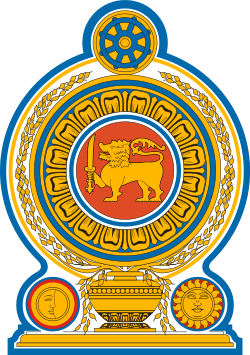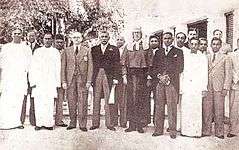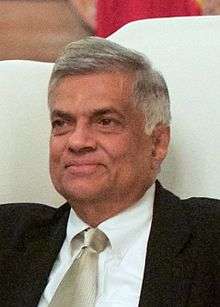Prime Minister of Sri Lanka
| Prime Minister of Sri Lanka ශ්රී ලංකා අග්රාමාත්ය இலங்கை பிரதமர் | |
|---|---|
|
| |
|
| |
| Style |
Mr. Prime Minister (Informal) The Honourable (Formal and diplomatic) |
| Member of | Cabinet |
| Reports to | Parliament |
| Residence | Temple Trees |
| Appointer | President of Sri Lanka |
| Term length | Five years |
| Constituting instrument | Constitution of the Democratic Socialist Republic of Sri Lanka |
| Inaugural holder | Don Stephen Senanayake |
| Formation | 14 October 1947 |
| Succession |
First in the presidential line of succession |
| Website | Prime Minister's Office |
 |
| This article is part of a series on the politics and government of Sri Lanka |
|
|
Political parties |
|
|
|
|
Foreign policy |
|
Related issues
|
The Prime Minister of the Democratic Socialist Republic of Sri Lanka (Sinhalese: ශ්රී ලංකා අග්රාමාත්ය Sri Lanka Agramathya; Tamil: இலங்கை பிரதமர்) is the leader of the cabinet business in Sri Lanka. However, the President is both head of state and head of government in Sri Lanka.
History

The post of Prime Minister of Ceylon was created in 1947 prior to independence from Britain and the formation of the Dominion of Ceylon in 1948. United National Party leader D. S. Senanayake became the first Prime Minister of Then Ceylon in 1947 after independence. In 1972 when Sri Lanka became a republic the name of the post changed to Prime Minister of Sri Lanka. With a Westminster-based political system established the Prime Minister was the head of government therefore held the most powerful political office of the country at the time. This changed with a constitutional change in 1978, when the Executive Presidency was created, making the President both head of state and head of government. Until 1978 the Prime minister was also the Minister of Defence and External Affairs. The Prime Minister is appointed by the President as a member of the cabinet of ministers. In the event the post president is vacant, the Prime Minister becomes the acting president until Parliament convenes to elect a successor or new elections could be held to elect a new president. This was the case with H.E. President Dingiri Banda Wijetunge. United National Party leaders Dudley Senanayake and Ranil Wickramasinghe together with Sri Lanka Freedom Party leader Sirimavo Bandaranaike was appointed three times to the position. With passing of the 19th amendment to the constitution in 2015, the prime minister was granted more powers when appointing ministers and leading the cabinet.
The current Prime Minister of Sri Lanka is Ranil Wickremesinghe, he was appointed by President Maithripala Sirisena on 9 January 2015. This was the third time that Wickramasinghe was appointed Prime Minister of Sri Lanka.
Official residence and office

The official residence of the prime minister is the Prime Minister's House most commonly referred to as Temple Trees. The Prime Minister's Office is located on Sir Ernest de Silva Mawatha (formerly known as Flower Road) in Colombo.
Last election
| Alliances and parties | Votes | % | Seats | |||
|---|---|---|---|---|---|---|
| District | National | Total | ||||
United National Front for Good Governance[lower-alpha 1]
|
5,098,916 | 45.66% | 93 | 13 | 106 | |
United People's Freedom Alliance
|
4,732,664 | 42.38% | 83 | 12 | 95 | |
| Tamil National Alliance[lower-alpha 7] | 515,963 | 4.62% | 14 | 2 | 16 | |
| Janatha Vimukthi Peramuna | 543,944 | 4.87% | 4 | 2 | 6 | |
| Sri Lanka Muslim Congress[lower-alpha 3] | 44,193 | 0.40% | 1 | 0 | 1 | |
| Eelam People's Democratic Party | 33,481 | 0.30% | 1 | 0 | 1 | |
| Independents | 42,828 | 0.38% | 0 | 0 | 0 | |
| All Ceylon Makkal Congress[lower-alpha 2] | 33,102 | 0.30% | 0 | 0 | 0 | |
| Democratic Party | 28,587 | 0.26% | 0 | 0 | 0 | |
Buddhist People's Front
|
20,377 | 0.18% | 0 | 0 | 0 | |
| Tamil National People's Front[lower-alpha 8] | 18,644 | 0.17% | 0 | 0 | 0 | |
| Ceylon Workers' Congress[lower-alpha 4] | 17,107 | 0.15% | 0 | 0 | 0 | |
| Frontline Socialist Party | 7,349 | 0.07% | 0 | 0 | 0 | |
| United People's Party | 5,353 | 0.05% | 0 | 0 | 0 | |
| Others | 24,467 | 0.22% | 0 | 0 | 0 | |
| Valid Votes | 11,166,975 | 100.00% | 196 | 29 | 225 | |
| Rejected Votes | 517,123 | |||||
| Total Polled | 11,684,098 | |||||
| Registered Electors | 15,044,490 | |||||
| Turnout | 77.66% | |||||
List of Prime Ministers
See also
Notes
- ↑ The UNFGG contested under the name and symbol of UNP.
- 1 2 The ACMC contested separately in one district (Ampara) and with the UNFGG in other districts.
- 1 2 The SLMC contested separately in two districts (Batticaloa and Vanni) and with the UNFGG in other districts.
- 1 2 The CWC contested separately in three districts (Badulla, Kandy and Kegalle) and with the UPFA in other districts.
- ↑ The CF contested separately in two districts (Nuwara Eliya and Vanni) and with the UPFA in other districts.
- ↑ The LP contested separately in four districts (Colombo, Galle, Kurunegala and Matara) and with the UPFA in other districts.
- ↑ The TNA contested under the name and symbol of ITAK.
- ↑ The TNPF contested under the name and symbol of ACTC.
References
- ↑ "Parliamentary Election - 17-08-2015 - Official Election Results ALL ISLAND RESULTS". Department of Elections, Sri Lanka.
- ↑ "Parliamentary Election - 17-08-2015 - Official Election Results COMPOSITIOIN OF THE PARLIAMANT". Department of Elections, Sri Lanka.
External links
- Parliament of Sri Lanka - Handbook of Parliament, Prime Ministers

